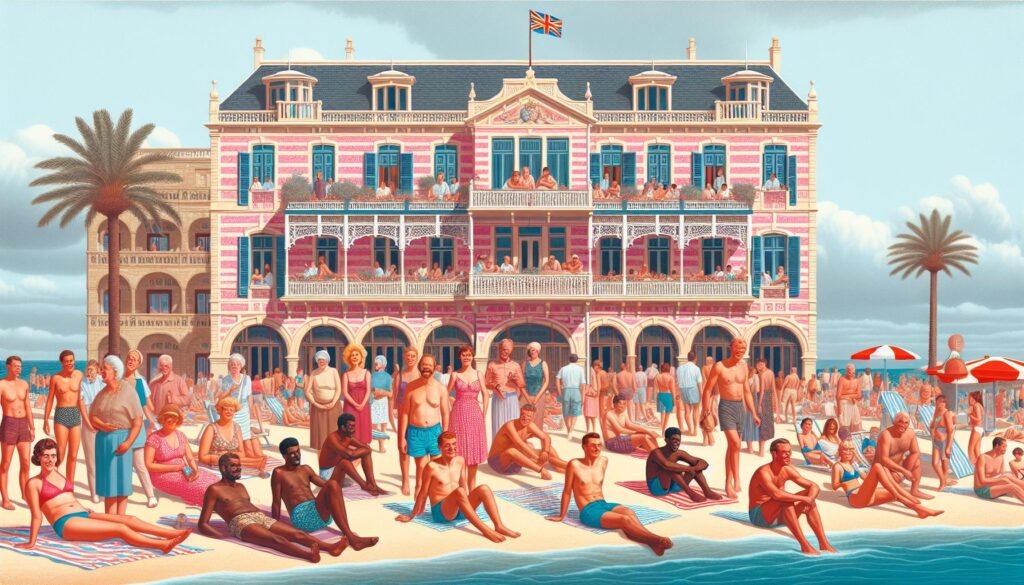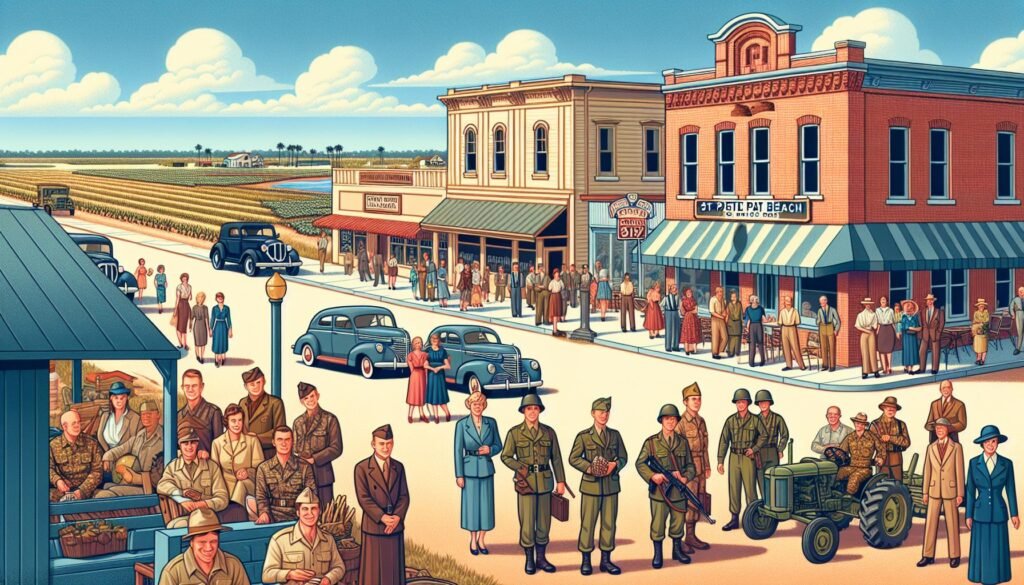Thomas Rowe: The Visionary Behind the Pink Palace
When I first learned about Thomas Rowe, the visionary who brought the Don CeSar to life, I was instantly captivated by his story. Born in 1872 in Ireland, Rowe emigrated to America, where he eventually conceived the idea for the hotel that would become a beacon of luxury and elegance on St. Pete Beach.
Rowe’s inspiration for the Don CeSar stemmed from a romance that reads like a fairy tale. While studying in London, he fell in love with Lucinda, a beautiful opera singer. They met regularly at the fountain in Hyde Park, where they dreamt of building a pink castle by the sea. However, their love was not meant to be; Lucinda’s parents disapproved, and the couple was tragically separated. This heartache fueled Rowe’s determination to bring their dream to fruition, albeit solo.
In 1924, Rowe’s vision began to take shape. He invested his fortune into creating the “Pink Palace,” a name the Don CeSar still proudly bears today. His obsession with detail ensured that the hotel was a masterpiece of Mediterranean and Moorish architectural styles, adorned with luxurious amenities unheard of at the time.
- Groundbreaking: 1926
- Opening Day: 1928
- Initial Construction Cost: $1.2 million
- Original Amenities: Spa, tennis courts, ballroom
Despite the initial skepticism from locals, who doubted the success of such an extravagant venture, the Don CeSar quickly became the epitome of high society’s vacation spot. Presidents, celebrities, and literary giants walked its halls, basking in the lavishness that Thomas Rowe meticulously curated.
Rowe’s hands-on approach didn’t stop at the design and construction. He was known to personally greet guests, ensuring their stay was nothing short of magnificent. His dedication turned the Don CeSar into not just a hotel, but a cherished experience, setting the standard for hospitality at the time.
Tragically, after Rowe died in 1940, the future of the Pink Palace faced uncertainty. Yet, Rowe’s legacy of resilience and unmatched luxury lived on, guiding the Don CeSar through its various reincarnations—each honoring the visionary’s original dream.
Construction and Grand Opening in 1928
The genesis of what would become the Don CeSar Hotel was as much an act of love as it was a testament to Thomas Rowe’s unwavering perseverance. I can’t help but marvel at the stories of its construction which began in earnest in 1926. It’s said that Rowe poured an astonishing $1.2 million into making the Don CeSar a reality, an astronomical sum at the time.
Here’s a quick breakdown of the construction costs:
| Aspect | Cost in 1920s USD |
|---|---|
| Initial Construction | $1,000,000 |
| Furnishings and Decorations | $200,000 |
| Total | $1,200,000 |
Crafting such a monumental structure required not just funds but vision. The Pink Palace’s design was influenced by the Mediterranean and Moorish architectural styles that Rowe so adored, a reflection of the romantic aura surrounding his memories with Lucinda. Every tower, and every archway seemed to whisper a part of their love story. I’m always astounded by how personal the architecture feels as if each brick was laid with care and each flourish had a purpose.
The grand opening of the Don CeSar Hotel on January 16, 1928, was nothing short of spectacular. Imagine the roaring twenties in full swing, with flapper dresses and jazz providing a lively backdrop to the unveiling of this pink jewel on the sands of St. Pete Beach. The hotel immediately drew the attention of well-heeled travelers and socialites from around the globe, eager to see this testament to luxury and enduring love. It wasn’t just a hotel; it was a symbol of reaching for the impossible, a tangible piece of dreams woven firmly into reality.
The amenities offered were ahead of their time, setting a new standard for luxury accommodations. Guests were treated to opulent rooms, exquisite dining options, and leisure facilities that included a golf course, tennis courts, and sea-facing swimming pools. It’s no wonder the Don CeSar quickly became known as the playground for the rich and famous, a place where elegance and service reign supreme.
The Don CeSar During World War II

As World War II unfolded, the story of the Don CeSar took a dramatic turn. While it might seem that a luxury hotel and a global conflict are worlds apart, they collided in a way that forever changed the fate of the “Pink Palace”. In 1942, just as the shadows of war darkened every corner of the globe, the U.S. government requisitioned the Don CeSar, transforming it from an opulent sanctuary for the wealthy into a critical asset for the war effort.
I’ve always found it particularly fascinating how the hotel, once a symbol of love and luxury, was repurposed during these trying times. The sprawling halls and lavish rooms, which had once echoed with the laughter of the elite, were now filled with the hurried steps of military personnel. The Pink Palace was reimagined as a Submarine Watchtower and later as a convalescent center for soldiers returning from the war. This period marked a profound shift in the hotel’s history, emphatically signifying its versatility and resilience.
During its time as a military hospital, the Don CeSar’s grand ballrooms and dining rooms were converted into areas for rehabilitation and recovery. The beautiful beachfront property, known for its ability to captivate and enchant guests, played a vital role in the soldiers’ recuperation. It’s a testament to the healing power of beauty and tranquility, even in the midst of world-changing events.
The hotel’s transformation didn’t stop there. After the war, the Don CeSar faced yet another reimagining. In 1945, the building was purchased by the U.S. Veterans Administration and continued to serve as a place of healing. It was later used as a regional office for the VA before the curtains of its military chapter closed. The transition from a luxurious hotel to a facility serving the needs of returning soldiers and veterans underscores an essential part of its legacy — its ability to adapt and serve throughout varying chapters of American history.
Celebrity Visits and Notable Events Throughout the Years
As the Don CeSar Hotel transitioned back to its original glamour post-World War II, it regained its status as a beacon for celebrities, dignitaries, and memorable events. I’ve always been fascinated by the rich history of this iconic hotel, and diving into its star-studded past only deepens my appreciation for its legacy.
One of the early prominent guests was F. Scott Fitzgerald, known for capturing the essence of the Roaring 20s in his literature. Imagining him walking the same hallways I’ve strolled through sends shivers down my spine. The hotel’s allure didn’t stop with literary figures; it extended to the glitzy Hollywood elite. Stars like Clarence Darrow and Lou Gehrig graced the Pink Palace with their presence, adding to its legendary status.
It wasn’t just individual celebrities that made the Don CeSar a notable landmark; it was also the host to a plethora of significant events. One unforgettable moment in its history was when it served as the backdrop for the movie “Once Upon a Time in America.” The hotel’s picturesque setting and opulent design made it the perfect choice for such a high-profile project.
Throughout the 70s and 80s, the hotel continued to attract a diverse array of famous faces. Musicians, actors, and even politicians would often choose the Don CeSar as their retreat away from the public eye. The privacy and luxury it offered were unmatched, making it a haven for those looking to escape the hustle and bustle of their everyday lives.
What stands out to me the most, however, is how the Don CeSar has remained relevant throughout the decades. Its ability to adapt and evolve while still maintaining its historic charm is truly remarkable. Whether hosting lavish weddings, important business conferences, or serving as a serene getaway, the hotel has continued to be a place where memories are made.
The Don CeSar’s significance goes beyond just its physical beauty or historical architecture. It’s about the experiences, the people, and the stories that have passed through its doors. Each visitor, whether a world-renowned celebrity or a family on vacation, contributes to its rich tapestry, ensuring that the Pink Palace will continue to be cherished for generations to come.
Preservation and Modern-Day Legacy
When I first stepped foot into the Don CeSar, I was immediately struck by its blend of historical charm and modern elegance. It’s clear to me now that preserving its grandeur while staying current has been a pivotal part of the hotel’s ongoing story. I’ve learned that in the late 20th and early 21st centuries, the hotel underwent significant renovations to ensure it met contemporary standards without sacrificing its historic essence. This delicate balance of old and new is something that I’ve always admired in historic properties.
Through conversations with staff and a bit of digging into the hotel’s recent history, I discovered that millions of dollars have been invested into upgrading the facilities and amenities. However, these renovations always kept the hotel’s iconic pink façade and Spanish Moorish architecture at the forefront, ensuring they remain unaltered. It’s the attention to detail in these preservation efforts that stands out to me. For instance, the lobby, with its original 1920s flooring and grand staircase, still serves as the heart of the hotel, welcoming guests with its timeless beauty.
The hotel has also embraced modern sustainability practices, something I deeply appreciate. They’ve implemented energy-efficient lighting, water conservation measures, and even a recycling program. This commitment to sustainability not only caters to the eco-conscious traveler but also ensures that the hotel continues to reduce its environmental impact. It’s a forward-thinking approach that shows how historic hotels can lead in modern environmental stewardship.
But it’s not just about the building or eco-friendly practices. The Don CeSar’s legacy is equally defined by its role in the community and the hospitality industry. It has become a major employer in the area, and it actively participates in local charitable events and organizations. For many folks here, the Don CeSar isn’t just a luxury hotel; it’s a venerable institution that has supported and grown with the community over decades.
Engaging with local culture, the Don CeSar hosts events that celebrate St. Pete Beach’s rich history and vibrant community. From art shows featuring local artists to music festivals that draw crowds from all over, the hotel serves as a cultural hub, connecting guests and locals alike.
Walking through the halls of the Don CeSar, I felt enveloped by stories of the past while seeing the very active role it plays today.
Conclusion
The Don CeSar Hotel has truly mastered the art of preserving its rich history while embracing the future. It’s fascinating how they’ve kept the essence of the past alive, ensuring every corner tells a story, yet they’ve not shied away from modernity. Their commitment to sustainability and community involvement only adds to their charm, making it more than just a place to stay—it’s a part of the community’s soul. Whether it’s through their architecture, events, or environmental efforts, the Don CeSar continues to weave its historical significance with contemporary relevance, proving it’s not just a landmark but a living legend.



